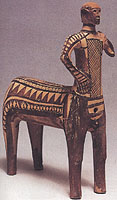
 Monsters with the upper part of a man and body of a horse; rarely, in the early period and especially for senior Centaurs, the forelegs are human. They appear fighting heroes such as Herakles or Theseus (Centauromachy); the latter at the wedding of Peirithoos, whose wedding they disrupt. They represent the wilder animal instincts which need to be controlled in a civilized society, and could be thus used to signify the barbarian (Persians, etc.). When not engaged in a mythical context (see Chiron, Kaineus, Pholos, Nessos) they are shown as hunters. Their home is Thessaly but some of their adventures take place in Arcadia.
Monsters with the upper part of a man and body of a horse; rarely, in the early period and especially for senior Centaurs, the forelegs are human. They appear fighting heroes such as Herakles or Theseus (Centauromachy); the latter at the wedding of Peirithoos, whose wedding they disrupt. They represent the wilder animal instincts which need to be controlled in a civilized society, and could be thus used to signify the barbarian (Persians, etc.). When not engaged in a mythical context (see Chiron, Kaineus, Pholos, Nessos) they are shown as hunters. Their home is Thessaly but some of their adventures take place in Arcadia.
Above left: Archeological Institute, Eretria © Archeological Institute, Eretria Licence Plate 11 UK 1007 126
Above right: Theseus and centaurs. Detail from an Athenian black-figure clay vase, about 600-550 BC. Florence, Museo Archeologico Etrusco 4209 © Museo Archeologico Etrusco